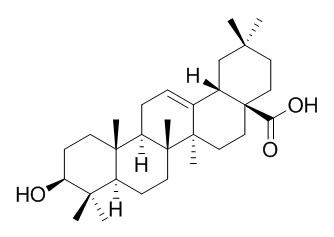Natural Products
Oleanolic acid
| Catalog No. | CFN98800 |  |
| CAS No. | 508-02-1 | |
| Molecular Weight: | 456.7 | |
| Molecular Formula | C30H48O3 | |
| DBs | [PubChem]:274951704 [ChEMBL]:37659 [PCIDB]:19064 |
Standard InChI:
InChI=1S/C30H48O3/c1-25(2)14-16-30(24(32)33)17-15-28(6)19(20(30)18-25)8-9-22-27(5)12-11-23(31)26(3,4)21(27)10-13-29(22,28)7/h8,20-23,31H,9-18H2,1-7H3,(H,32,33)/t20?,21?,22?,23-,27-,28+,29+,30-/m0/s1
Biological Activity
Oleanolic acid is a pentacyclic triterpenoid compound with a widespread occurrence throughout the plant kingdom. In nature, the compound exists either as a free acid or as an aglycone precursor for triterpenoid saponins, in which it can be linked to one or more sugar chains. Oleanolic acid and its derivatives possess hepatoprotective effects, and anti-inflammatory, antioxidant, or anticancer activities. [1]
Oleanolic acid may be a promising agent to disturb adipocyte differentiation and suppress obesity-associated inflammation, 25mol/L oleanolic acid-treated adipocytes can significantly repress visfatin production possibly through blocking PPAR activation.[2]
Oleanolic acid and ursolic acid exhibit anti-HCV activity at least partly through suppressing HCV NS5B RdRp activity as noncompetitive inhibitors,could be used as potential HCV antivirals that can be applied to clinic trials either as monotherapy or in combination with other HCV antivirals.[3]
Oleanolic acid may be a possible bioactive agent that blunts adipogenesis and adipokine inflammation, can suppress adipocyte differentiation-associated resistin and adipogenesis production by disturbing the Tyk2-STAT1/3 signaling pathway and promoting SOCS3 expression. [4]
Product
References
[1] Pollier J, Goossens A. Phytochemistry, 2012, 77(5):10-15.
[2] Sung H Y, Kang S W, Kim J L, et al. Nutr Res, 2010, 30(12):831–39.
[3] Kong L, Li S, Liao Q, et al. Antivir Res,2013, 98(1):44-53.
[4] Kim H S, Sung H Y, Kim M S, et al. Nutr Res, 2013, 33(2):144-53.
[5] Zhou C, Chen K, Sun C, et al. Biomed Chromatogr, 2007, 21(7):755-61.
Product Use Citation





